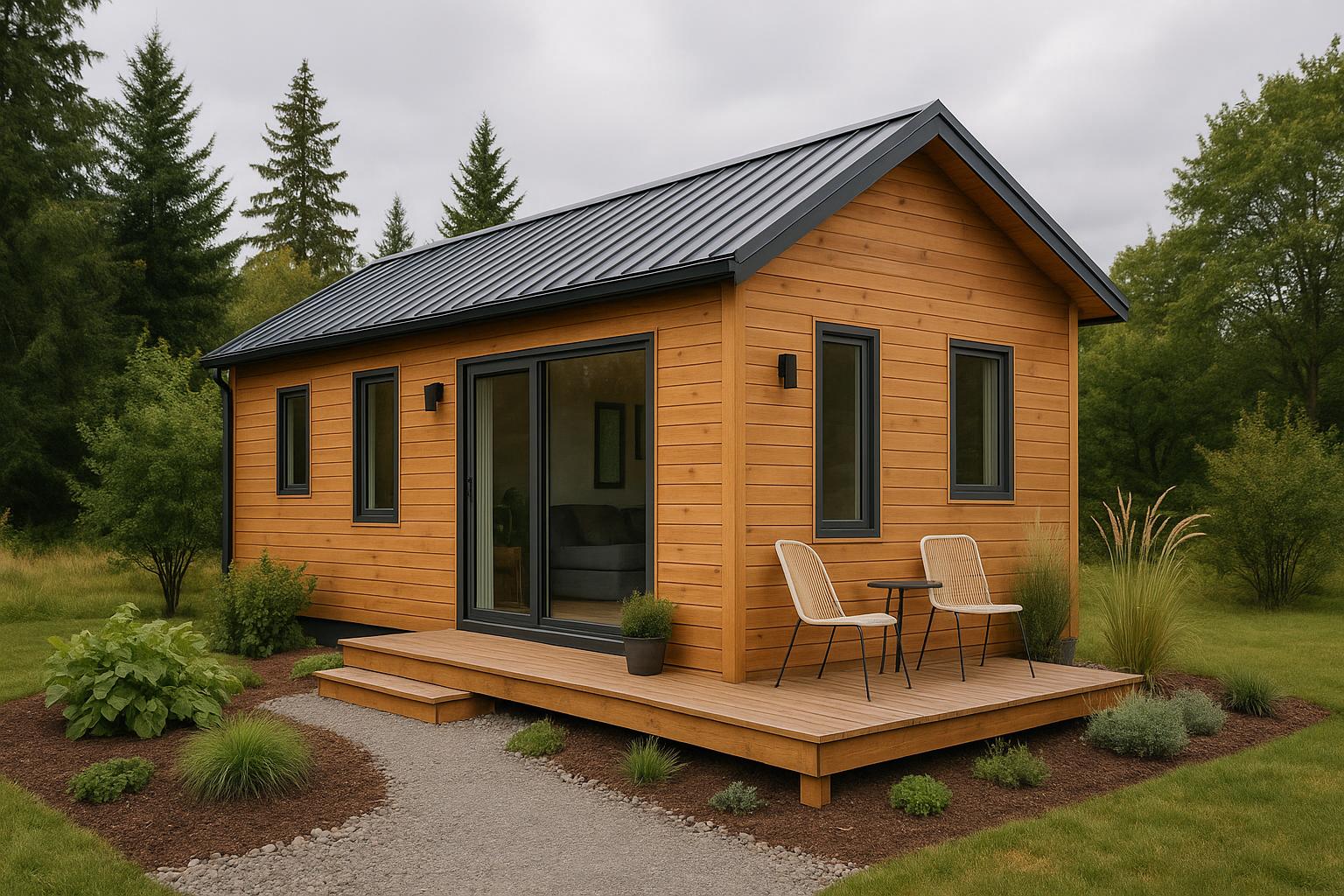
Estimated reading time: 10 minutes
The Ultimate Guide to Designing a Low Allergen Tiny Home: Healthier Living for Canadians
Key Takeaways
- Low Allergen Design is essential for maintaining a healthier home environment.
- Prioritizing smart ventilation and open layout planning can sharply reduce indoor allergens.
- Selecting hypoallergenic and sustainable materials is key to achieving superior respiratory health.
- Routine cleaning and proper maintenance ensure a long-lasting low allergen environment.
Table of contents
- Introduction: What Is a Low Allergen Tiny Home?
- Understanding Allergens and Their Impact on Respiratory Health
- Key Design Strategies for Low Allergen Tiny Homes and Canadian ADUs
- Material Recommendations for Building Healthy Homes
- Special Considerations for Canadian ADUs
- Practical Tips for Maintaining a Low Allergen Environment
- Conclusion
- Frequently Asked Questions
Introduction: What Is a Low Allergen Tiny Home?
A low allergen tiny home is a purpose-built, compact living space designed to minimize allergen levels. For Canadians with asthma or respiratory sensitivities, these homes prioritize healthier breathing environments without compromising on comfort or efficiency. By focusing on tiny home design, complying with Canadian ADU requirements, and emphasizing respiratory health, both families and individuals can benefit from a safer, cleaner living space.
Careful design, thoughtful material choices, and strategic planning can make a dramatic difference for allergy and asthma sufferers. This guide offers step-by-step recommendations rooted in real-world experience and research, ensuring that every design decision supports a healthier lifestyle. Learn more about innovative approaches at Allergic Living and My Chemical Free House.
Understanding Allergens and Their Impact on Respiratory Health
Common Triggers in Low Allergen Tiny Homes
- Dust Mites: Thrive in textiles and bedding.
- Mold: Forms in moist or poorly ventilated areas, especially where condensation occurs.
- Volatile Organic Compounds (VOCs): Emitted by paints, finishes, adhesives, and manufactured wood products.
- Pet Dander: Fine skin flakes from animals that settle on various surfaces.
In compact spaces such as tiny homes and ADUs, these allergens can concentrate rapidly. For additional guidance on managing pet dander in small spaces, visit this resource.
Effects on Asthma and Respiratory Health
Allergens can trigger airway inflammation, induce asthma attacks, cause congestion, and generally impair daily living for those with respiratory sensitivities. Maintaining a low allergen tiny home is crucial for long-term respiratory health, allowing for improved air quality and breathing comfort.
Further insights can be found at My Chemical Free House and Allergic Living.
Key Design Strategies for Low Allergen Tiny Homes and Canadian ADUs
Ventilation: Breathing Easy in a Healthy Home
- Install Heat Recovery Ventilators (HRVs) with HEPA filtration to continually refresh indoor air.
- Opt for decentralized ventilation units that provide targeted moisture control, especially during harsh Canadian winters.
- Maintain indoor humidity between 30-50% by utilizing exhaust fans in kitchens and bathrooms.
For more detailed information on ventilation, check out Air Quality in Tiny Homes and view additional insights via this video resource.
Layout Considerations: Smart Tiny Home Design Choices
- Simplify floor plans with open spaces to minimize dust-trap corners.
- Reduce the use of upholstered furniture, opting instead for easily cleaned surfaces.
- Ensure storage areas and furniture are designed for optimal visibility and accessibility.
Guidance on optimizing space is available at Tiny Home Design in Canada.
Material Selections for Surfaces
- Choose sealed, non-porous finishes like MgO wallboard or clay plasters to reduce allergen accumulation.
- Incorporate moisture barriers and waterproofing, especially in kitchens and bathrooms.
- Utilize smooth, continuous surfaces for countertops and backsplashes to ease cleaning.
Learn more about allergen-friendly materials at this resource and Bengarratt Tiny Healthy Homes.
Material Recommendations for Building Healthy Homes
Paints, Adhesives, and Finishes
- Use low-VOC paints and finishes to minimize off-gassing and chemical irritants.
- Select adhesives and sealants that are certified for allergy-sensitive applications.
- Allow sufficient off-gassing time before fully inhabiting the space.
For more tips, view this video.
Building Materials for Tiny Home Design
- Magnesium Oxide (MgO) Wallboard and Clay Plaster offer mold-resistant and hypoallergenic benefits.
- Consider materials like Poplar Wood and Cotton Batt Insulation for durability and safety.
- Solid Surface Countertops provide seamless cleaning and reduce allergen traps.
Additional recommendations can be found at Bengarratt Tiny Healthy Homes and My Chemical Free House.
Flooring and Insulation Options
- Opt for sealed hardwood, ceramic tiles, or cork floors that are easy to clean and resist dust accumulation.
- Utilize insulation like Blown-In Cellulose or Cotton Batt to promote thermal comfort and reduce allergen buildup.
These choices are critical for maintaining consistent indoor air quality and overall respiratory health.
Special Considerations for Canadian ADUs
Climate-Related Design
- Utilize robust insulation and vapour permeable materials to adapt to Canada’s freeze/thaw cycles.
- Incorporate continuous air barriers and external venting to minimize moisture and mould.
For further strategies on climate resilience, please visit Building for Climate Resilience in ADUs and this Allergic Living article.
Regulation and Code Compliance
- Consult local Canadian building codes to ensure proper ventilation, insulation, and heating standards.
- Work with certified builders knowledgeable in high indoor air quality standards.
More details on permitting and regulations can be found here.
Design Integration for Health
- Incorporate energy-efficient windows and passive solar layouts to promote air flow and reduce condensation.
- Use non-toxic adhesives and finishes throughout the construction.
For more design integration tips, reference Bengarratt Tiny Healthy Homes.
Practical Tips for Maintaining a Low Allergen Environment in Tiny Homes
Daily and Seasonal Cleaning Routines
- Daily: Wipe surfaces, vacuum using a HEPA filter, and spot clean any spills.
- Weekly: Wash bedding at high temperatures and clean hidden corners and under furniture.
- Seasonal: Deep clean floors, inspect ventilation systems, and check for moisture or mould.
Supplemental Air Quality Devices
- Consider adding a HEPA air purifier and a dehumidifier to better manage indoor air quality.
- Follow manufacturer guidelines for cleaning and maintaining these devices.
Indoor Plant Considerations and Clutter Reduction
- When including houseplants, opt only for hypoallergenic types and use sterile potting soil.
- Keep possessions organized and minimize excess textiles that could harbor dust.
For additional organizational tips, explore Minimalist Living: Decluttering Tips & Simple Routines.
Conclusion: The Path to a Low Allergen Tiny Home in Canada
A well-designed low allergen tiny home or Canadian ADU can transform respiratory health and elevate everyday living. By focusing on effective ventilation, streamlined layouts, and health-oriented materials, you ensure a clean, comfortable, and resilient living space all year round.
Thorough planning, compliance with local codes, and ongoing maintenance are key. Explore detailed resources such as Allergy-Friendly Tiny Homes: Design & Materials, Modular & Tiny Homes for Wellness, and Tiny Home Design in Canada for further inspiration.
Breathe easier, live smarter—invest in your health with the right tiny home design.
Frequently Asked Questions
Q: What exactly is a low allergen tiny home?
A: It is a compact living space designed with materials, layouts, and systems that minimize allergen presence and improve respiratory health.
Q: How does ventilation improve indoor air quality?
A: Proper ventilation, including systems like HRVs with HEPA filters, continuously refreshes indoor air, reducing the concentration of allergens and moisture.
Q: What materials are best for reducing allergens in tiny homes?
A: Materials such as sealed MgO wallboard, clay plasters, low-VOC paints, and solid surface countertops help create surfaces that are easy to clean and less likely to harbor allergens.
Q: How can I maintain a low allergen environment long-term?
A: Regular cleaning routines, proper maintenance of air quality devices, and periodic deep-cleaning are essential for sustaining a low allergen environment.

Leave a Reply